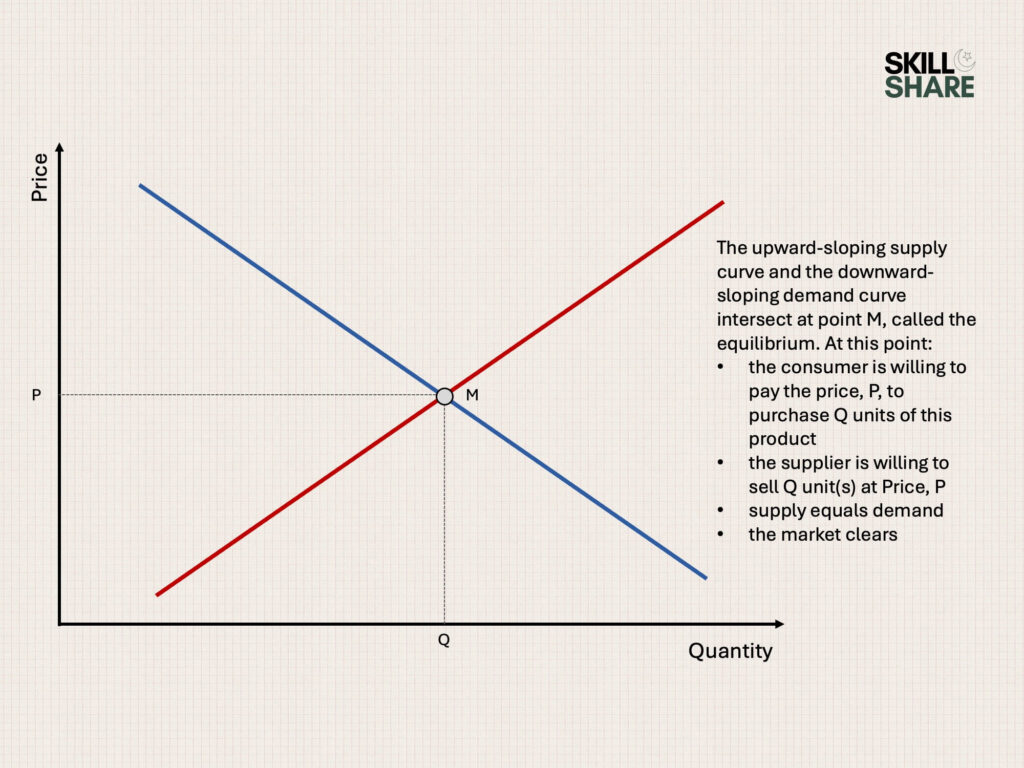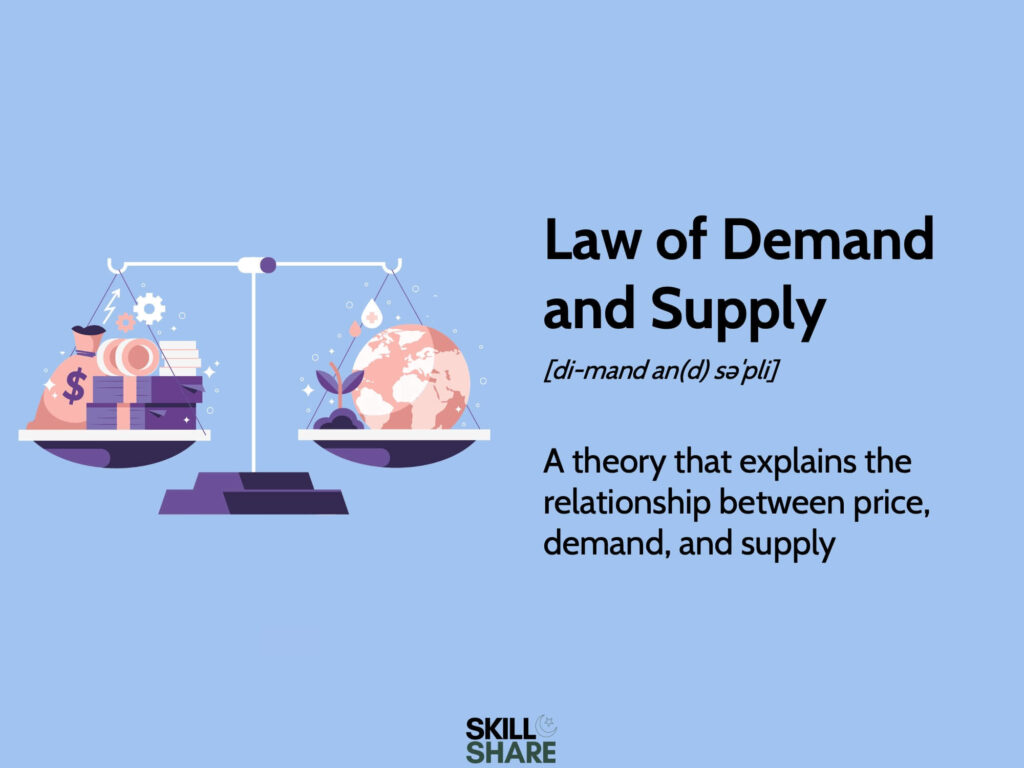What is the law of demand and supply?
The laws of demand and supply are two of the most fundamental economic principles that explain the impact of changes in the price of a product, good or resource on its demand and supply.
Conceptually, as the price of a good or service increases, its supply increases while its demand falls. On the flip side, as the price decreases, the supply decreases while the demand increases.
The relationship between demand and supply at different price levels can be plotted on a graph with curves. Demand is illustrated with a demand curve, while supply is illustrated with the supply curve. The point where the two curves intersect is known as equilibrium, or the market clearing price, and at which both demand and supply are equal.

Understanding the Law of Supply and Demand
Theoretically, the price reflects a balance between what the buyer is willing to pay and what the seller is willing to accept; hence, demand equals supply. This relationship of demand and supply has been observed and established over many years.
Crucially, demand and supply may not always react proportionally to price changes. The extent to which price changes affect demand or supply is called price elasticity. Goods with high price elasticity of demand will experience significant shifts in demand based on price changes. Conversely, necessities are relatively inelastic, as people cannot easily forgo them. Hence, their demand varies less relative to price changes.
Price discovery, based on demand and supply curves, assumes a free marketplace where buyers and sellers are free to make a transaction or refuse it, depending on the price. Factors such as taxes, government regulations, supplier market power, availability of substitutes, and economic cycles can all shift supply or demand curves or alter their shapes. Nevertheless, as long as buyers and sellers are free to choose, prices are fundamentally influenced by the forces of demand and supply.
Let us delve into how demand and supply react to changes in price.
The Law of Demand
The law of demand states that demand for a product is inversely related to its price, considering everything else constant. In other words, an increase in price will decrease demand, while a decrease in price will increase demand.
This relationship is depicted by a demand curve that slopes downward from left to right, indicating the inverse relationship between price and demand.
The change in demand for a good or service due to a change in consumers’ purchasing power is called the income effect. Conceptually, the goods that follow this principle are often called inferior goods: As the consumer’s income increases, he or she can opt for a higher-quality product.
Besides the income effect, demand is also affected by the substitution effect. The substitution effect is the decrease in sales for a product that can be attributed to consumers switching to cheaper alternatives when its price rises.
The Law of Supply
The law of supply states that, keeping all else constant, the supply of a good or service will increase if its price increases, as firms look to maximize profits. Conversely, if the price of a good or service falls, the quantity supplied will decrease. This principle keeps the market in equilibrium.
Higher prices give suppliers an incentive to supply more of the product, assuming that the costs don’t increase by the same coefficient. On the other hand, lower prices result in squeezed margins that curb supply. Therefore, supply slopes are upward, sloping from left to right.
Just as demand is influenced by various factors, such as income and preferences, supply is also subject to constraints that affect its price elasticity. Supply constraints, such as limited resources or production capacity, can restrict the ability of suppliers to respond quickly to changes in price, resulting in a less elastic supply curve.
Similarly, supply shocks, such as natural disasters or geopolitical events, can lead to sudden and significant changes in the price of essential commodities. These shocks can disrupt supply chains, reduce availability, and cause prices to fluctuate disproportionately.
Equilibrium Price
The equilibrium price also called the market-clearing price, is the point at which demand matches supply, producing a market equilibrium.
The intersection of the upward-sloping supply curve and the downward-sloping demand curve determines the equilibrium price. This point represents the optimal balance between demand and supply, ensuring there is neither excess supply nor unfulfilled demand in the market. The exact level of the equilibrium price is influenced by various factors that shape the positions and shapes of the demand and supply curves.
Factors Affecting Supply
Several factors influence supply, including production costs, technological advancements, input prices (such as raw materials and labour), expectations about future prices, government policies (such as taxes and regulations), and the number of producers operating in the market.
Factors Affecting Demand
Just like supply, several factors affect demand. Consumer income, preferences, and willingness to substitute one product for another are among the most important determinants of demand.
What Is a Simple Explanation of the Law of Supply and Demand?
If you’re wondering how the supply of a product matches its demand, or how the market prices are set, the law of demand and supply provides the answers.
When prices rise, the supply of a product also increases but demand decreases. The lower demand puts pressure on prices to fall, thus increasing the supply. Eventually, they reach the market-clearing price, which represents a point where demand and supply are in equilibrium.
Why Is the Law of Supply and Demand Important?
The law of demand and supply is essential for an economy, as it helps investors, entrepreneurs, and economists understand and forecast market conditions.
For instance, if a company thinks of raising the price of a product, it expects demand to decrease and analyzes price elasticity and substitution effects to decide whether to proceed or not.
Example of the Law of Supply and Demand
An example of the Law of Supply and Demand was seen in the gasoline market during the COVID-19 pandemic. As gas consumption plummeted due to the pandemic’s onset, prices dropped rapidly because the industry faced storage limitations. This price decline signalled suppliers to reduce gas production. Conversely, in 2022, the increase in crude oil prices provided producers with a strong incentive to ramp up output.
The bottom line
The law of demand and supply reflects two crucial economic principles that explain the relationship between price, supply, and demand. The law of demand asserts that as the price increases for a given resource, product, or good, its demand falls; conversely, as the price falls, demand increases.
On the supply side, the law states that as price increases, producers supply more of a resource, product, or good; as the price falls, so does supply.
The price at which supply matches demand is called equilibrium, the point at which the market clears. The law of demand and supply is pivotal in helping all participants in a market assess and predict future conditions.
KEY TAKEAWAYS
- The law of demand dictates that as the price of a product or resource increases, its demand decreases, and vice versa.
- In contrast, the law of supply holds that higher prices encourage producers to increase the supply of a good, while lower prices tend to reduce supply.
- A market-clearing price is a point where supply and demand are balanced, visually depicted as the intersection of the supply and demand curves on a graph.
- Price elasticity refers to the extent to which changes in price affect demand and supply. Basic necessities have relatively inelastic demand, meaning their demand is less affected by price changes.

